The College of Science Impact blog has a post by Elana Roldan about recent graduate and Goldwater Scholar Madalyn Gragg
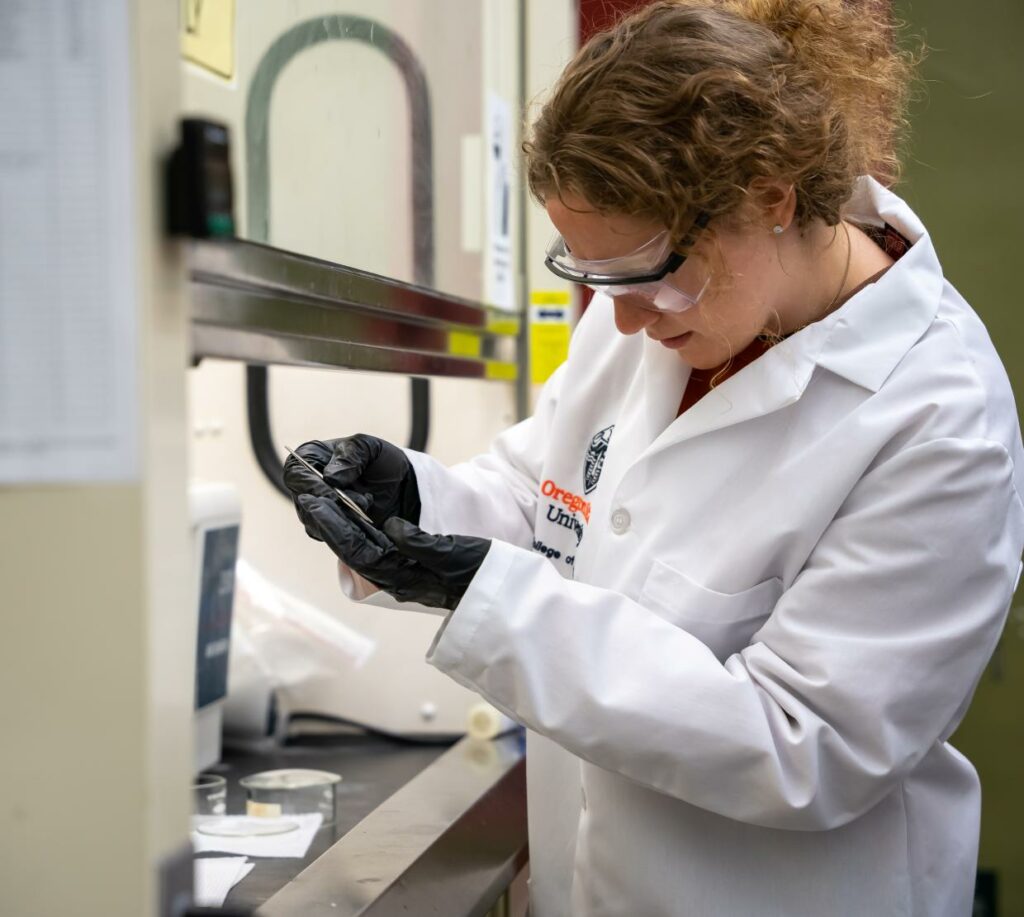

The College of Science Impact blog has a post by Elana Roldan about recent graduate and Goldwater Scholar Madalyn Gragg

Reprinted from an Impact post by Hannah Ashton on January 17, 2025
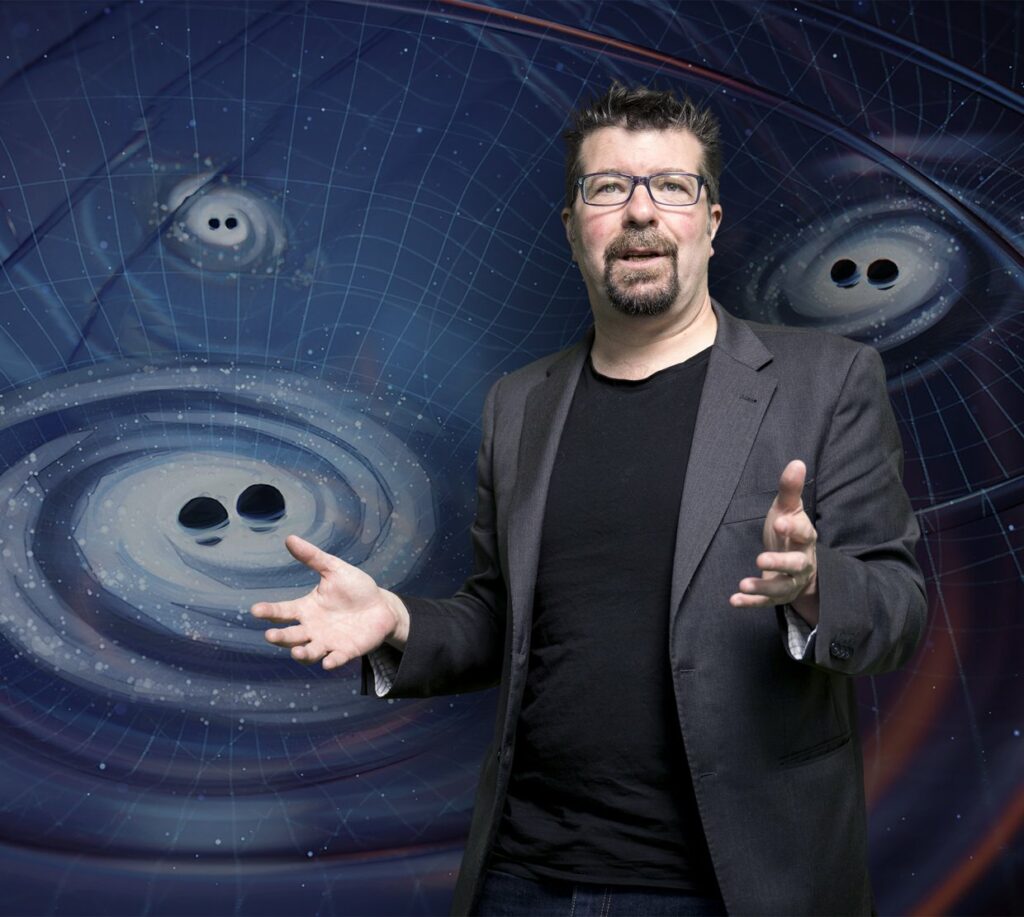
Xavier Siemens, a renowned astrophysicist and professor at Oregon State’s College of Science, has been awarded the prestigious 2025 Bruno Rossi Prize, one of the highest international honors in high-energy astrophysics, for his groundbreaking work uncovering evidence of binary supermassive black holes.
Siemens shares the honor with Maura McLaughlin and the North American Nanohertz Observatory for Gravitational Waves (NANOGrav) Physics Frontiers Center whose achievement in gravitational wave research marks a significant step forward in understanding the dynamics of the Universe and its deep mysteries.
In June 2023, Siemens led an international team of nearly 200 researchers, including OSU students, in detecting low-frequency gravitational waves reverberating across the universe—ripples in spacetime first predicted by Albert Einstein over a century ago. This discovery provided the first direct evidence of the stochastic gravitational wave background, caused by merging binary supermassive black holes.
NANOGrav announced their groundbreaking discovery in June 2023. The news was picked up around the world including by the New York Times, Nature, Reuters, AP News, The Guardian, The Washington Post, BBC, NPR and more.
“We are incredibly proud of Dr. Siemens,” said Dean Eleanor Feingold. “The Bruno Rossi Prize is one of the most prestigious honors in high-energy astrophysics and places him among the world’s leading scientists. His groundbreaking achievements continue to inspire his students, who pursue the universe’s most profound questions with his mentorship.”
Presented annually by the High Energy Division of the American Astronomical Society, the Bruno Rossi Prize recognizes exceptional contributions to high-energy astrophysics. Awarded since 1985, this prize is highly regarded in the astrophysics community, often highlighting work that pushes the boundaries of our understanding of the universe. The award will be formally presented at the next HEAD meeting, where Siemens and his collaborators will deliver a lecture on their findings.
Siemens’ achievements not only advance the field of astrophysics but also inspire the next generation of scientists, including graduate and undergraduate students at Oregon State, where he continues to mentor and conduct research that pushes the boundaries of human knowledge.
For International Women’s Day, I’m reposting a history of one of our most distinguished alumni, Dr. Chung Kwai Lui. Dr. Lui was the first woman to receive a doctorate in any field from OSU and was nationally recognized for her work on the Manhattan project and at Westinghouse on phosphor development. The Wei Family Private Foundation has established a scholarship in honor of her and her husband Hsin Hsu Wei.
This was originally posted on our website as OSU’s First Woman Physics PhD by Ken Krane.
There is more information about Dr. Lui and legacy provided by the Wei Family Private Foundation in this article from the College of Science.

Chung Kwai Lui was born in Canton, China in 1909. In 1929, she enrolled at Lingnan University, which had been established as a Christian college in 1888 by American missionaries in Guangzhou. The reputation of the college grew quickly, and by 1918 the leading U.S. universities, including Harvard, Yale, and Stanford, were accepting its students for graduate programs. Miss Lui chose physics as her major and completed her undergraduate degree in 1933. In addition to the regular curriculum of physics courses, she also took courses in science teaching, and from 1933 until 1936 she taught physics at the middle-school level. At the same time she enrolled in graduate courses in physics at Lingnan University.
In 1936, the Oregon State chapter of Phi Kappa Phi (an academic honor society) offered Miss Lui an exchange scholarship, which covered her tuition and room. She moved into Snell Hall, which was then a women’s dormitory. She was one of thefirst two students to enroll in the newly formed physics graduate program at Oregon State. Within one year, she had completed and defended her M.S. thesis, Diffusion Phenomena in Strong Magnetic Fields, under the supervision of Professor Willibald Weniger, who was also chair of the Physics Department. Her experimental work studied the magnetic field and temperature dependence of the time for the diffusion of aqueous dye solutions. She continued on to study for a Ph.D. inphysics, which she completed in 1941 under the supervision of Professor James Brady. Her thesis, The Crystal Photoeffect in D-Tartaric Acid Single Crystals, concerned a process analogous the better-known photoelectric effect in metals, in which light shining on certain crystals causes a current to flow. She immediately published her Ph.D. thesis work in the Physical Review, the leading U.S. journal of physics research, as a single-authored paper (vol. 60, pages 529-531).
Following the completion of her Ph.D. she taught as an instructor at Oregon State for several years, and then she was hired by the Westinghouse Lamp Research Laboratory in New Jersey, where she studied phosphors and fluorescent lamps. Westinghouse was also investigating materials for possible use as filaments in incandescent lighting, among which was uranium. So during the Manhattan Project, which was the highly secret U.S. effort to develop the atomic bomb during World War II, the Westinghouse expertise in purifying microscopic quantities of uranium was instead applied to kilogram quantities, and Dr. Lui turned her skills to that project.
Although she had originally entered the U.S. on a student visa, which would normally have required her to return to China to apply for admission as a permanent resident (the path to citizenship), the U.S. government did not want her knowledge of the atomic research program to fall into the hands of the Communist Party, which had taken over control of China. So in 1949 the Congress passed, and President Harry Truman immediately signed, a bill “for the relief of Doctor Chung Kwai Lui,” which read in part “the Attorney General is authorized and directed to record Dr. Chung Kwai Lui as having entered the United States in 1936 for permanent residence.” This bill in effect retroactively changed the status under which she had entered the U.S. and thus permitted her to stay. Also in 1949 she married Mr. Hsin Hsu Wei, who had emigrated from China after the war, received a master’s degree in electrical engineering from Columbia University, and also was employed by Westinghouse.
Dr. Chung Kwai Lui Wei remained at Westinghouse, mostly doing research into the properties of phosphors, until she retired in 1974. She published several papers in physics journals on her work with phosphors, and she is the holder of 2 patents, one in the U.S. and the other in Canada. She died in 2008 at the age of 98. She and her husband (who died in 2000) recognized the value that higher education had played in their lives, and they left their estate to establish the Wei Family Private Foundation, which supports scholarships for students of Chinese ancestry who are studying engineering or science at Oregon State or electrical engineering at Columbia. This wonderful legacy will continue to provide support for students at OSU who hope to follow the exemplary path established by the first woman to earn a physics Ph.D. at Oregon State.
Oregon State’s Department of Physics recently underwent a major reform of their graduate program and requirements.
Introduction:
U.S. Physics Departments generally require that doctoral students complete core advanced courses in Quantum Mechanics, Electrodynamics, Classical Mechanics, and Statistical Mechanics, with additional electives depending on the field of study. Most Departments also require that all students demonstrate proficiency by passing written or oral examinations in the core topics. These examinations have different names (Preliminary, Qualifying or Comprehensive) but generally involve several multi-hour written tests. Students are normally given several chances to pass but if they fail to pass these examinations by the end of their second year, they are usually asked to leave the program.
At OSU, as at most Physics Departments, graduate students in their first 1-2 years are normally supported as graduate teaching assistants with significant teaching responsibilities while they are taking the required courses. As graduate and undergraduate courses start at the same time in the Fall, new graduate students typically find themselves teaching several undergraduate laboratory or recitation sections and taking three challenging courses, right after they arrive. The combination of a new environment, challenging courses, and teaching duties, all at once, can become overwhelming. Institutions can help with preparation, for example with pre-term orientation sessions, but the transition is still very difficult.
Oregon State physics recently did a major reassessment of the early requirements for our doctoral program which has led to three major changes.
First, entering graduate students are assessed individually by a group of faculty on arrival. The Core Graduate Advising Committee meets with all incoming students to assess their preparation for the Core graduate courses. Students who have missed a component (for example Statistical Mechanics) in their undergraduate preparation, or feel underprepared, are given the chance to take the appropriate undergraduate course in the first year, and then proceed to the advanced courses in the second year.
Second, the graduate teaching load in the first term has been reduced and the third core course for entering students is now replaced by a pedagogy course, taught by a faculty member with experienced graduate teaching assistants as mentors. This helps incoming graduate teaching assistants gain the skills they need very early in their graduate career.
Third, the written comprehensive examination has been replaced by a series of assessments over the first 2-3 years. These include the grades in the core courses and demonstration of written and oral communication skills. In particular, candidacy for the doctorate now requires a writing sample and a researched presentation on a general topic posed by the committee and communicated to the students several weeks before the exam.
These changes resulted from a multi-year process, initiated by both faculty and graduate students. Both groups realized that talented students were being lost due to overload in the first term or later, through failure to pass the written examination or, more often, out of worry that they would not pass after a failed attempt.
Inputs and proposed solutions:
Several years ago, a group of graduate students, led by students in the Physics Education Research group, researched and presented a paper on studies of known sources of bias in high stakes testing. In parallel, the faculty had long recognized that the skills needed to be a successful physicist were not solely correlated with an ability to take timed tests. Over the years, various reforms of the written examination had been tried, with little change in outcomes; talented students were still leaving the program. An elected graduate student representative committee was formed, with an elected (by the students) faculty liaison to provide input. A series of Town Halls led by the graduate representatives were held. At those Town Halls, students described their concerns about the program, in particular the sink or swim nature of the first term and the high stakes exams.
The faculty formed a committee of Associate Professors to recommend major changes to the doctoral program requirements. Their work was informed by Oregon State’s training in unbiased hiring practices and the modern methods they used in developing learning objectives and assessments for their courses. The committee spent most of a year formulating the learning objectives for a physics doctorate. 5 objectives were identified:
2. Learn Physics Expertly Learn and apply new concepts, methodologies, and techniques by identifying and engaging with various resources including, e.g., research literature and books, both individually and in collaboration with peers and other experts.
3. Create and Share Novel Physical Insight Design and conduct original research within a chosen specialty and disseminate the results through effective presentations in professional settings and in the scientific literature. Research expectations include: familiarity with primary literature, identification of central issues and knowledge gaps, ability to develop original questions, ability to identify and mitigate obstacles in research, ability to engage in productive discussions and work synergistically within a group or collaboration, and ability to write effective scientific publications that include citations and clear descriptions of methods and results.
4. Communicate with Learners Design and facilitate physics learning experiences at an appropriate level of sophistication for a broad range of audiences (e.g., colleagues, students, and the general public).
5. Do Physics Ethically and Inclusively Conduct themselves ethically and inclusively in all professional settings, in accordance with the American Physical Society code of ethics (https://www.aps.org/policy/statements/ethics.cfm), as well as proactively identify areas where ethical and/or discrimination issues may arise and articulate strategies for dealing with them.
Curricula and projects were then proposed to cover each of the objectives and new methods of assessing mastery were proposed. In particular, the committee proposed replacement of the written comprehensive examinations with grades in core courses and replacement of the general physics portion of the doctoral candidacy exam with a writing sample and a prepared pedagogical presentation on a set topic.
In addition, the first-year graduate curriculum and graduate teaching training were revamped to make the first year more inviting and flexible. The substantial faculty effort previously put into setting three written examinations per year was redirected into the expanded Core Graduate Advising committee to provide initial and continuing personal advising to beginning students.
Implementation:
A professional facilitator worked with the faculty committee to prepare for a retreat to discuss the new requirements. At the retreat, after considerable discussion, the new requirements were approved by consensus of the faculty. Graduate students were then given an opportunity to provide feedback on the proposed changes. Their comments were generally positive but led to several clarifications and improvements. The new system was voted upon in February 2020 and became the only policy for students arriving in the Fall of 2020. Most existing students who had not yet advanced to candidacy have also opted to follow the new program.
Preliminary Assessment:
It is early to do a full evaluation but preliminary feedback from 1st year students indicates that the flexible course scheduling and emphasis on training in the first term have had positive results. Core faculty were initially concerned that their new role as grading gatekeepers would work against their roles as champions for their students. However, the Core Advising Committee’s attention to student needs early in the program has led to increased student success in the core courses.
The doctoral qualifying process has become somewhat more complex with the addition of writing samples and set presentation topics requiring additional planning.
The new methods may lead to changes in admissions policy. Talented students with unusual backgrounds are likely to do better in the program, thanks to more intensive advising and flexibility early in the program. However, the absence of the required examinations may lead to greater attention to undergraduate grades as a predictor of ability in academic courses.
Summary:
Based on student input and faculty experience, Oregon State Physics has substantially modified the initial experience for incoming students and evaluation practices. Initial results are positive, with improved retention.
Sept. 29, 2021
Oregon State Physics is leading a Department of Energy Office of Science funded project to design computing and software infrastructure for the DUNE experiment. DUNE is a future neutrino experiment that will aim a neutrino beam from Fermilab, in Batavia Illinois, at a very large detector in the Homestake mine in Lead, South Dakota. The experiment is currently under construction with a 5% prototype running at CERN in 2018 and 2022 and the full detector expected in 2029. These experiments generate data at rates of 1-2 GB/sec, or 30 PB/year which must be stored, processed and distributed to over 1,000 scientists worldwide.

The project “Essential Computing and Software Development for the DUNE experiment” is funded for 3M$ over 3 years, shared among 4 Universities (Oregon State, Colorado State, Minnesota and Wichita State) and three national laboratories (Argonne National Laboratory, Fermi National Laboratory and Brookhaven National Laboratory). The collaborators will work with colleagues worldwide on advanced data storage systems, high performance computing and databases in support of the DUNE physics mission. See https://www.dunescience.org/ for more information on the experiment.
PI Heidi Schellman (Oregon State Physics) leads the DUNE computing and software consortium which is responsible for the international DUNE computing project. Physics graduate student Noah Vaughan helps oversee the global grid processing systems that DUNE uses for data reconstruction and simulation and recent graduate Amit Bashyal helped design the DUNE/LBNF beamline. Graduate student Sean Gilligan is performing a statistical analysis of data transfer patterns to help optimize the design of the worldwide data network. Postdoc Jake Calcutt recently joined us from Michigan State University and is designing improved methods for producing data analysis samples for the ProtoDUNE experiment at CERN.
One of the major thrusts of the Oregon State project is the design of robust data storage and delivery systems optimized for data integrity and reproducibility. 30 PB/year of data will be distributed worldwide and processed through a complex chain of algorithms. End users need to know the exact provenance of their data – how was it produced, how was it processed, was any data lost – to ensure scientific reproducibility over the decades that the experiments will run. Preliminary versions of the data systems have already led to results from the protoDUNE prototype experiments at CERN which are described in https://doi.org/10.1088/1748-0221/15/12/P12004 and https://doi.org/10.1051/epjconf/202024511002.
As an example of this work, three Oregon State Computer Science Majors (Lydia Brynmoor, Zach Lee and Luke Penner) worked with Fermilab scientist Steven Timm on a global monitor for the Rucio storage system shown below. This illustrates test data transfers between compute sites in the US, Brazil and Europe. The dots indicate compute sites in the DUNE compute grid while the lines illustrate test transfers.
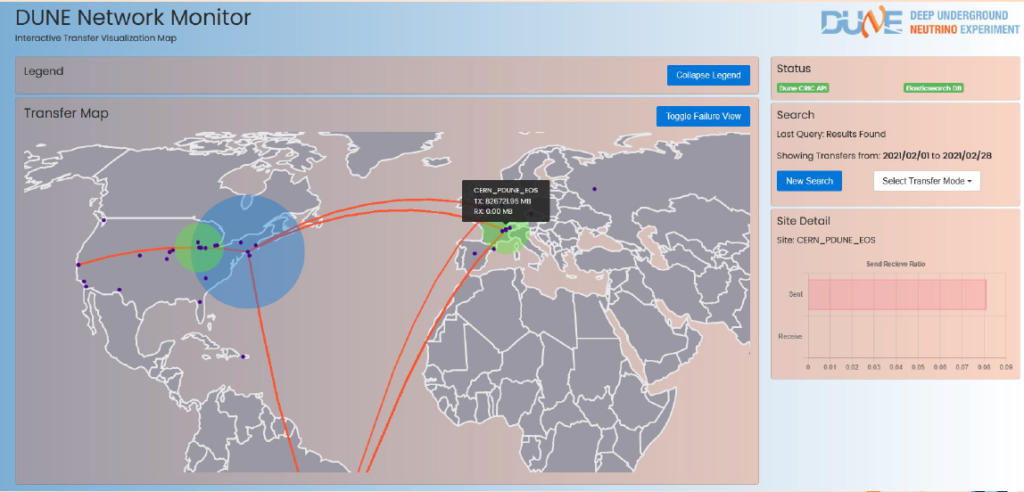
Other projects will be a Data Dispatcher which optimizes the delivery of data to CPU’s across the DUNE compute systems and monitoring of data streaming between sites.
The Physics Department at Oregon State University stands with the Black community. The continued murders of Black people by police are a consequence of long-standing, unacceptable social and economic systems that dehumanize people, particularly the Black community.
We recognize that the academy, and our department by extension, is complicit in these structures of racism. The conspicuous dearth of Black department members points to the racism and structural inequities that exist within our hiring and recruitment processes, our teaching and mentoring, and our broader social culture. Removing these structures is long overdue. We will strive to promote equity across all areas, including but not limited to: race, gender, gender identity or expression, national or ethnic origin, religion, age, marital status, sexual orientation, disability, veteran status, and economic status. We are committed to making our workplace and classroom environments supportive of all community members by: (i) creating policies and a culture that work against historical oppressions, and (ii) seeking a diversity in the recruitment, selection, promotion, and celebration of students, staff, faculty, and other scientists, that is representative of the global community.
One of the most recent steps the department has taken is forming the Diversity Inclusion Climate and Equity (DICE) Committee. This committee is composed of members representing all subsets of the physics community – from undergraduates to faculty and staff – and is charged with recommending policies and resources that will help foster a more welcoming and inclusive physics environment. The DICE Committee is seeking new members this academic year.
If you would like to get involved, or would like access to the department’s antiracism resource list, please contact physdice@lists.oregonstate.edu.
Current DICE members
Acacia Patterson (graduating)
Isabel Rodrigues
Xavier Siemens
Evan Thatcher
Three OSU Physics alums are among 2,046 graduate students nationwide to receive the NSF Graduate Research Fellowships Program award that pays stipend and partial tuition for 3 years. Congratulations to all three! See the Impact article from the College of Science for some more details about other College of Science GRFP recipients.
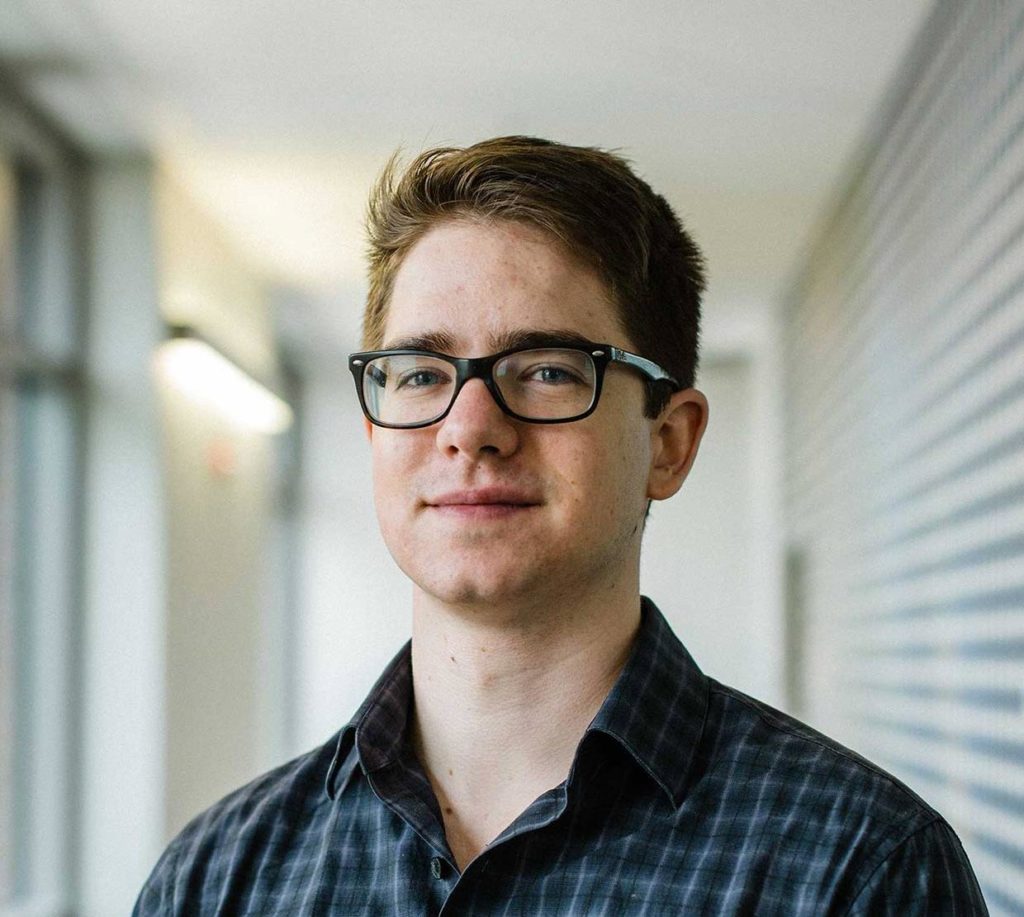
Mirek Brandt (BS in Physics & Mathematics 2018) worked in the Graham group while at Oregon State. His thesis was on The Impact of Crystal Morphology on the Opto-Electronic Properties of Amorphous and Organic Crystalline Materials. He won a Goldwater Scholarship as an undergraduate and then moved on to the University of California at Santa Barbara where he is doing his doctorate in Astrophysics.

Katelyn Chase (BS in Physics 2018) worked in Bo Sun’s biophysics laboratory during her time at OSU and wrote her thesis on Synchronized Cellular Mechanosensing due to External Periodic Driving. She is now a Ph. D. candidate at the Lewis-Sigler Institute for Integrative Genomics at Princeton University, conducting research in the Gitai bacterial biology laboratory, studying cytoskeletal proteins. She is interested in proteins involved in bacterial cell shape formation and maintenance. Her photo shows her in Iceland in January.

Patrick Flynn (BS in Physics and Mathematics, 2018) did his senior thesis project on Localized structures in a diffusive run and tumble model for M. xanthus, as part of the Complex Systems REU at the University of Minnesota with Arnd Scheel (Bo Sun was the local advisor). Patrick also contributed to the linear solver code for the Monte-Carlo simulations performed in David Roundy’s research group in Physics. Patrick is now a Ph. D. candidate in the Department of Applied Mathematics at Brown University. He is studying the Euler- and Vlasov-Poisson models appearing in plasma and astrophysics. His NSF GRFP proposal was about answering questions such as the existence and stability of solitary waves, or the existence of solutions containing many interacting solitary waves, for the Euler- and Vlasov-Posson equations. Patrick says he is “very enthusiastic about being able to address questions that have been partially addressed by the physics community to discover new mathematics, and in turn inform scientific discovery. Of course, my time at Oregon State was very formative in this regard, and I still heavily rely on what I learned in the mathematics and physics programs there. After all, I first learned what a dispersion relation was from David Roundy!” The accompanying picture shows Patrick on the Brown Campus.
See the Impact article from the College of Science for some more details about College of Science GRFP recipients.
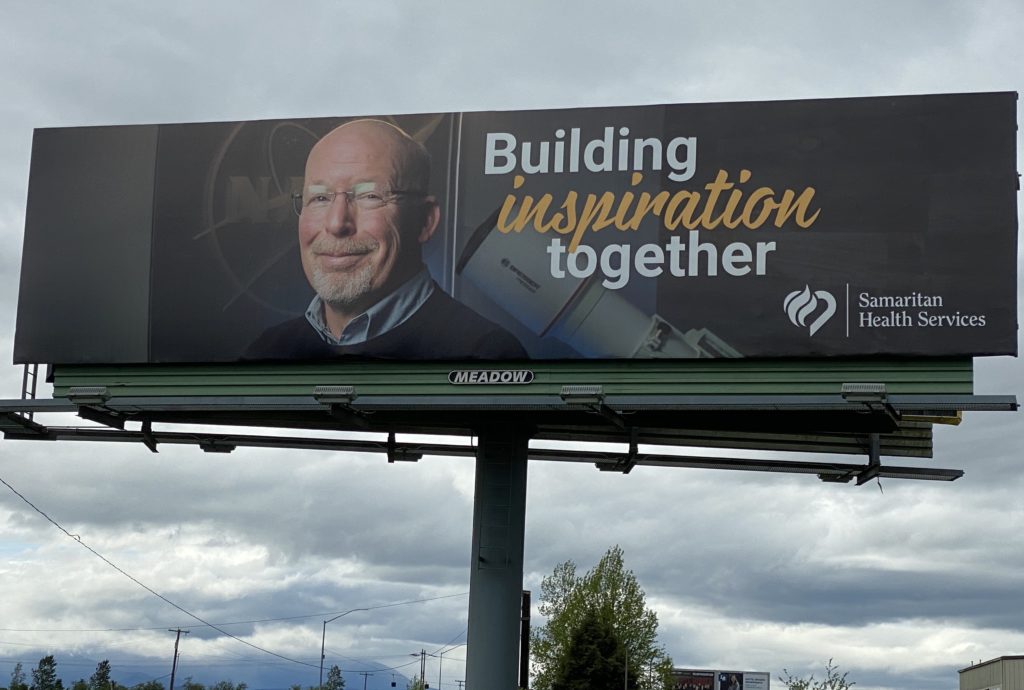
OSU Astronomer in Residence, Senior Physics Instructor and man-about-Corvallis Randall Milstein has been featured by Samaritan Hospital in an article and a huge billboard on OR34. See https://www.samhealth.org/randallm for the full article. You can meet Randy in person in Physics 104 (Descriptive Astronomy), the class he teaches to hundreds of students every term at Oregon State.
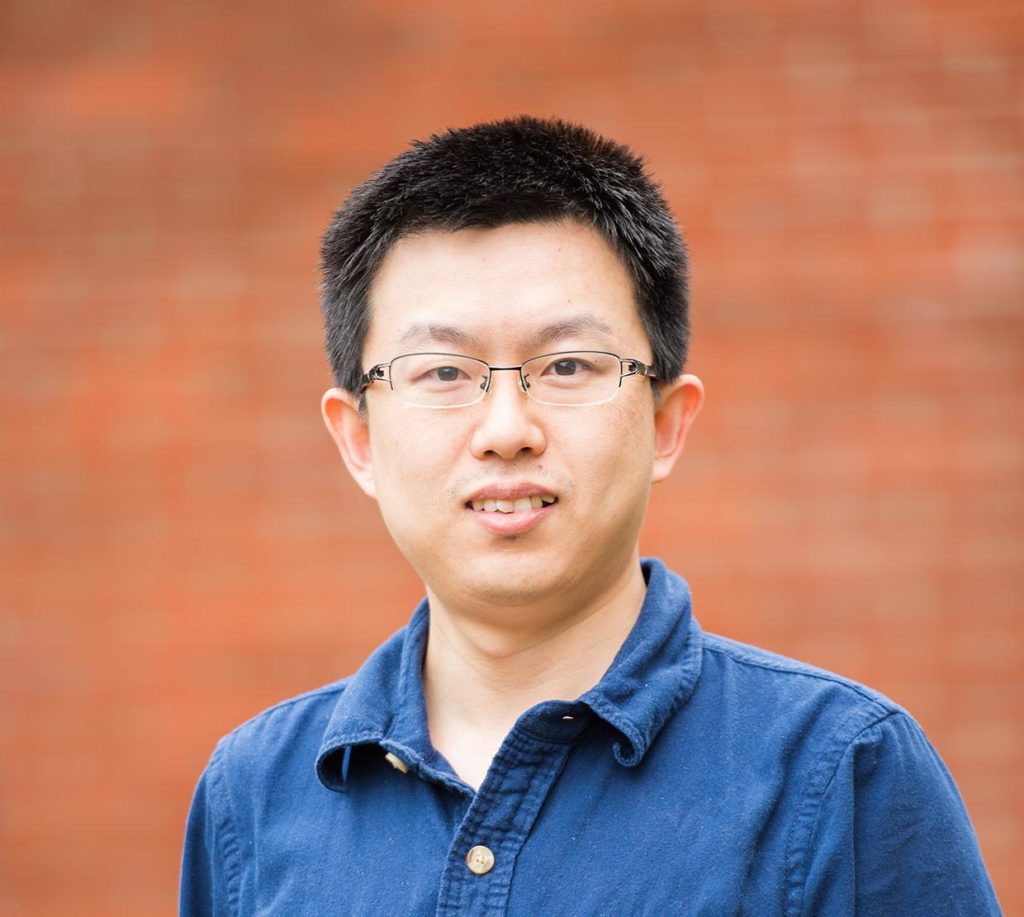
In December 2019, Associate Prof. Bo Sun received the Richard T. Jones New Investigator Award from the Medical Research Foundation of Oregon for his work on the biophysics of collective behavior in cells.
For more details on the award see the MRF awards site and the longer College of Science IMPACT article about Bo’s work.
And check out his research group at https://sites.google.com/site/biophysicsbosun/ to read about the successes of the large number of graduate and undergraduate students working in his lab.
Congratulations Bo!